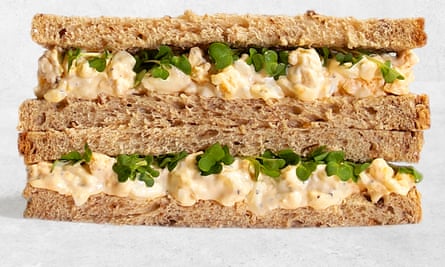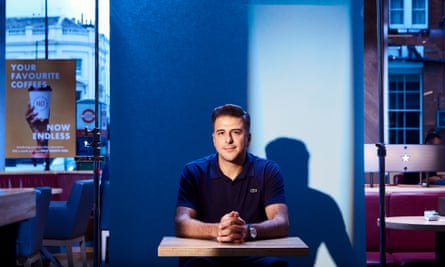The Pret a Manger head office in Victoria, London, has all the trappings of an internet startup: the open-plan kitchen offering free coffee, fruit and snacks; a red telephone box next to a meeting room where you can take a private call (Google’s office in London has those, too); a fibreglass cow grazing on fake grass in the atrium; and an area to host “town hall meetings” with a scattering of quirky cushions on a series of raised steps. On the steps is written: “Millions of healthy customers, thousands of opportunities, hundreds of shops, one vision, two founders.”
Of course, there are no longer thousands of opportunities for some of its employees. At the end of last month, the sandwich chain announced that nearly 2,900 of its 8,800 staff were being axed; 30 shops have closed; many of the ones that remain open are now shutting as early as 3pm; and the menu has been slimmed down.
The economic fallout caused by the Covid-19 lockdown has claimed many victims, but few have been quite as high profile as Pret – a chain that for years has flourished while selling falafel wraps, fruit salads and flat whites to office workers and commuters. With the majority of those customers still working mostly from home, Pret had to take drastic action.
The man who wielded the axe, chief executive Pano Christou, is showing me around the open-plan building, which now resembles a museum to early 21st-century office life rather than a vibrant workplace. There are people at their desks on the afternoon I visit, but fewer than 80 out of 210 head office staff. “I’ve been part of Pret for 20 years, and it’s been a great growth story. And then within a week and a half, it kind of goes like this,” Christou says, making a dramatic downward movement with his hand. Having to shut all the stores in March “was a hugely stressful moment”, he says, and it’s not back to normal yet. Before the redundancies, 320 people worked in this office; when Pret moved here in 2017, it had planned that eventually 500 would be based at its headquarters.
Despite the brutal restructuring, Christou has a disconcertingly boyish optimism as he shows me around the (one-way) system. Wearing multicoloured Puma trainers, skinny Jack Wills jeans (showing off his naked ankles) and a Lacoste polo shirt revealing a tattoo – it says “seize the day” in Thai – the 42-year-old has a bounce in his step. It’s not just the frequent smiles and the self-deprecating references to his south London background, but a sunny insistence that Pret will get through this crisis.
We pass a flatscreen on the wall that announces how many customers have scanned a QR code on their phone to sign up for a new scheme: pay £20 a month for up to five drinks a day. It is the day of launch for this subscription service, which Christou hopes will lure customers back into the shops. “Oh, look,” he says. “3pm: 16,500. That beats our target. We thought we’d do 2,000 or 3,000 on the first day.”
Considering that a latte (Pret’s single most popular item) costs £2.75, you’d only have to buy two coffees a week to get your money back. Isn’t this going to destroy your already very dented profits, I ask? “I guess there’s always that risk. But we need to move fast and we need to evolve and we need to innovate. And I think we need to take some risks,” he says. “If we sit and wait for things to change, that is a bigger risk than going out there and being bold.”
The coffee deal is just a number of “bold” initiatives that Christou is planning, to ensure that Pret does not become a relic of the commuter age, another name like Woolworths or Lyons Corner Houses – brands that once dominated the high streets of Britain, only to fall foul of changes in society. But while the Woolies pick’n’mix counter or the Lyons waitresses attract almost universal affection from consumers who remember them, people have a more ambivalent view of the Pret vegan kale and cauli macaroni cheese, or the chicken caesar and bacon baguette.

Right now, Pret’s problem is that it has become emblematic of a way of working, and living, whose return many do not relish. Andy Pratt, professor of cultural economy at City, University of London, tells me he is not surprised that Pret has become a useful whipping boy for those who are sceptical about the government’s push to get people back into city centre offices. (As Marina Hyde wrote in the Guardian: “Leave home. Forget the NHS. Save Pret.”) “In the past 10 or 15 years,” Pratt says, “so many people have spent their time eating at their desk. There’s been an intensification of work, and the grab-and-go approach has dominated. There’s also been a huge growth in the number of freelancers who need somewhere to work. Pret has become a poster child for all these changes in society.” He admits to being fond of the avocado wrap from Veggie Pret, a pilot project that has expanded to 10 branches in London and Manchester.
Speaking to customers in central London earlier this month, it’s clear that while the chain has many fans, there are others who tend to buy their lunch from Pret from force of habit more than anything else. “I’ve been going to Pret for so long it’s part of my personal tradition,” says Dean Stokes, 56, a senior administrator at University College London, clutching a soya latte. “I’ve been coming since the early 2000s. I’m not sure why – but back then it stood out as not being Starbucks, which was big, brash and American. And Pret’s sandwiches were clearly nicer and a bit healthier.”
Stokes is back in the office three days a week – a choice he’s made, rather than something enforced by his employer. He agrees that if most workers follow this pattern, many city centre businesses such as Pret will suffer. “I can see this is a better way of living – coming into the office for two or three days a week. My head says that the closure of lots of sandwich shops may not be a terrible thing; I accept the need for change. But my heart says it would be a great shame. I really like city centres: they are thrusting and dynamic, and that’s an enjoyable thing to be part of.”
Other customers shrug their shoulders when I ask if they’re upset about Pret’s troubles. Alex Cawthron, 26, is on her first day in a new job at a charity. She admits a bit sheepishly that she only came to Pret (she’s bought a posh cheddar baguette and an oat milk cappuccino) because she left her face mask on her desk. “And I know Pret allows you in without masks,” she says, explaining the staff tend not to ask if you are intending to sit down and eat (when you don’t need to wear a mask) or whether you are taking away (when you should). “It’s not the best coffee. Normally, I’d like to go to an independent cafe and get a really good coffee and a nice sandwich, even if it’s a bit more expensive. But my options are limited around here.”

That, of course, has been part of Pret’s strategy: plaster certain high-footfall locations with numerous branches. King’s Cross in London has eight Prets within a 500m radius of the station. There are more Prets on The Strand in London (four) than in the whole of Wales (three). Outside London, most Prets tend to be in transport hubs, shopping centres or office districts – exactly the areas where footfall has fallen. The company’s mantra, according to Christou, had been to follow the skyscrapers. “Now we need to follow the people,” he says.
But where are the people? Oliver McGuirk, 31, a video editor now back in the office three days a week, is sitting outside a Pret near Oxford Circus, having a chicken salad and a lemon and ginger drink. “They are too expensive,” he says. “But at least their food is fresh and it tastes good.” He says he’d welcome a branch opening nearer where he lives. “I’ve been thinking they should do those little coffee trucks. In Greenwich, someone’s converted an old red telephone box into a kiosk selling coffees. Why don’t they do that?”
Why not? Some have suggested Pret should buy ice-cream vans and trundle around residential areas offering sarnies at lunchtime. “At the moment: no,” says Christou when I ask if he’d try this. “Though never say never.”
He is, however, keen on making sure that, if people aren’t going to Pret, then Pret can come to them. More branches in suburban areas are on the cards. “It’s difficult at the moment, but it’s a great opportunity at the same time,” says Christou, who took over as chief executive in September last year, having previously run its UK business (the chain also has branches in other countries, including the US and France), as well as being chief operating officer. “I always knew it would be quite challenging to drive change through a business, but [Covid] has really given me the licence to rip up the rulebook.”
The first rule he’s ripped up is that Pret should not deal with third-party delivery companies. Previously, the company thought it was too risky to put its brand – which relies heavily on an energetically smiley workforce – in the hands of potentially grumpy motorcycle couriers. He signed up with Deliveroo last year as an experiment; once lockdown happened, he added Pret to the Just Eat and Uber Eats platforms.
“We’ve seen a tenfold growth since before Covid,” says Christou about home-delivery. “As it currently stands, it’s about 5-6% of total sales. Beforehand, it was more like 0.2%, maybe 0.4%.”
That’s an impressive level of growth, but surely long-term not many people will want to pay the typical £1.99 charge to have a £2.69 ham-and-cheese sandwich delivered? Christou points out that 80% of home deliveries take place in the evening, leaving just 20% for breakfast and lunch, Pret’s core market. “So we are developing a dinner menu. We see this as an opportunity.” He has opened a so-called “dark” kitchen in north London, making food that is only for delivery.
Pret has tried an evening meal before, and it was a flop. Five years ago, a branch offered a sit-down menu including Korean barbecue pulled pork hot pot after 6pm, along with a wine list, soft lighting and jazz. “It wasn’t overly successful,” Christou happily admits. But it wasn’t the food, it was the venue that was to blame, he says. “Let’s be honest, nobody’s going to go and have a nice dinner in a Pret shop. So I think this would just be an online delivery dinner proposition.” He won’t tell me what will be on the evening menu, only that it will be hot (the biggest selling dish on Deliveroo is currently macaroni cheese) and “craveable”.
Meanwhile, reaching customers outside central London is a matter of urgency. The bulk of office workers are resolutely staying away from the capital, according to Department for Transport data, which shows that in the first week of September, passenger numbers on the London Underground were running at around a third of their pre-lockdown level. Christou points out that branches in more residential areas of the city are doing relatively well: sales are running at 70% and improving.
Professor Laura Vaughan at UCL’s Bartlett School of Architecture specialises in the history of the high street, and tells me she thinks Pret and other sandwich chains could be just as successful in the suburbs. “The more that people are going to be working from home – and I suspect many of us will end up doing that a couple of days a week – the more you need a place out of the home, even if it’s not for the dreaded tapping away on a laptop. It might be for meetings: you need somewhere neutral that isn’t your house and isn’t your local cafe, where you may bump into friends or fellow parents from school. The anonymous chain has an advantage in that respect.”
Christou knows, however, that he has an uphill task in persuading people that Pret is not just for well-heeled office workers. “Sometimes people think it’s a bit expensive, it’s a bit posh,” he admits. That reputation isn’t just because of the red quinoa in the salmon and pickles bowl; it hasn’t been helped by its London-centric profile, and photographs showing a series of suited senior cabinet ministers, including Rishi Sunak and Michael Gove, pictured leaving Pret with their lunch during July, in what appeared to be a coordinated attempt to signal that people should return to their offices. Christou laughs when I bring this up, but then says: “Look, I’m keen to broaden its appeal.”

When he first applied for a job at Pret more than 20 years ago, he didn’t get it. “As a kid growing up, I didn’t have a broad palate,” he says. “I was very, very fussy, I didn’t eat my greens.” His father, a half-Italian, half-Greek Cypriot born in London, was a minicab driver. His mother, a Greek Cypriot, was a financial adviser at the Woolwich building society. When he bunked off school to play snooker (he says most of his friends wanted to emulate Jimmy White, who went to his Tooting comprehensive, Ernest Bevin College) he’d “go to the local fish and chip shop”.
His mother hoped he’d be the first in the family to go to university, but he left school at 17, after falling in love with his part-time job at the Wandsworth branch of McDonald’s. “My mother was very upset at the time. I just really loved hospitality – the interaction with people. Every day is a different day.” He says his five years at the company were far removed from the McJob label that the fast-food company attracted back in the 1990s. “It didn’t matter where you came from, what you looked like – if you worked hard enough they gave you that opportunity,” he says of the move from burger flipper to management.
He rose to become a supervisor at McDonald’s, and then applied for a job as assistant store manager at Pret just before the US fast-food chain briefly took a 33% stake in the sandwich chain. (Pret is now owned by a Luxembourg private investment company, JAB, which also owns Krispy Kreme and some large US sandwich chains.) It wasn’t just Pret’s ingredients that he struggled with (Christou says he loves everything on the menu now, except kimchi), but the format. “Twenty years ago, you used to walk into somewhere, pay for something, then get your food. I think having this array of food in fridges in front of you was a bit daunting.” It was only on the second attempt that he got a job at a different store, at the age of 22. He’s stayed with the company ever since, slowly working his way up.
The company was founded by two public school friends in 1986, Sinclair Beecham and Julian Metcalfe, who sold the last of their stake in 2018, when JAB bought it for £1.5bn. Before Christou, it was run by Clive Schlee, an Oxford graduate who had an urbane, patrician air when he toured the shops. Christou is a more approachable figure with his skinny jeans and tattoo: “Clearly, I’m from a very different background, and I am probably quite an untraditional CEO.”
He’s been coming into the office from his home in Coulsdon, near Croydon, every day since May. “I just felt guilty that I was sitting at home when my staff were coming in, on buses, on trains, into shops.” His Tiggerish enthusiasm surprises me, considering the few months he has just been through. “When you are restructuring a business, it is very difficult. But when we had completed the restructure at the end of August, you know, there was a real sense of relief that we could start moving forwards.” It’s only when I push him on the scale of the job losses that he says: “It was a horrid thing to go through. Yeah, it really was.”
But Pret is where he’s spent most of his working life; it’s where he met his wife, Vanessa, a fellow employee who worked her way up from the shop floor; it’s where he hopes to be overseeing restaurant openings and unveiling new dishes. Christou believes the company can flourish outside its skyscraper-dense heartlands – by appealing to people like him. “I look at my background and where I’ve come from. And I want kids with similar backgrounds, 16 years old, 17 years old, not saying: ‘I’m going to McDonald’s to get a Big Mac’, but ‘Actually, I can have a great, healthy, high-quality, nutritious lunch from Pret.’ That’s where I’d like to see us evolve over time.”
As he shows me out, he mentions that the shiny Pret HQ is up for sale. The fibreglass cow is being put out to pasture, the telephone box decommissioned. Will you move nearby, I ask? “I don’t know. We could even move out of London,” he says. The consumer may not be dead. But the central London office as we know it could well be.
Hold the porridge: Pret bestsellers, before and after lockdown

The biggest hitters, from coffee to croissants, show that breakfast has been overtaken by lunch.
Pre-lockdown
1 Coffee
2 Water, 500ml still
3 Breakfast tea
4 French butter croissant
5 Banana
6 Porridge
Post-lockdown
1 Coffee
2 Water, 500ml still
3 Tuna, mayo and cucumber baguette
4 Chicken caesar and bacon baguette
5 Chocolate croissant
6 French butter croissant

Comments (…)
Sign in or create your Guardian account to join the discussion